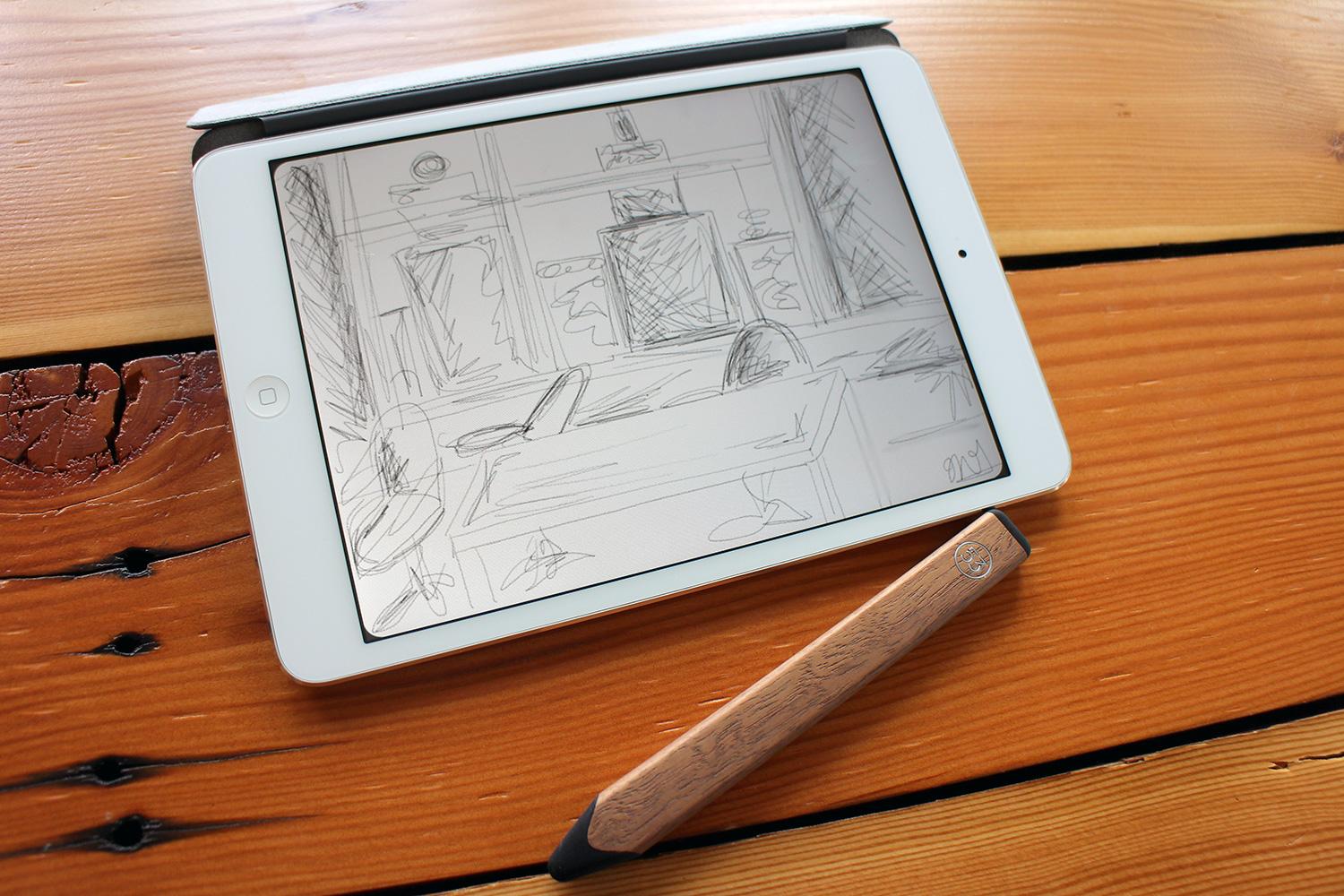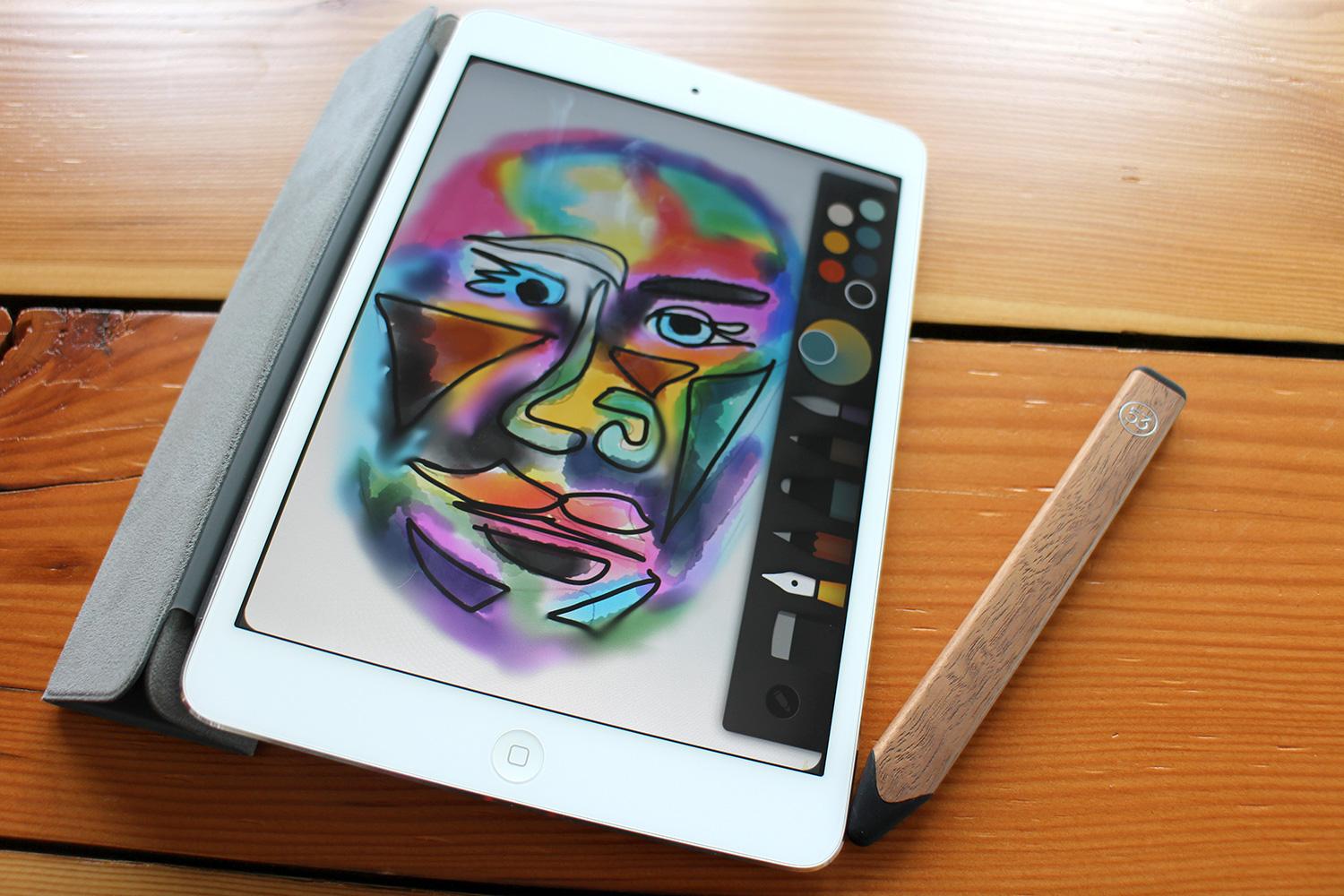When the iPad arrived in 2010, it was hardly viewed as a creative tool. Tablets were for browsing the Web, watching video and cruising Facebook – not art.
While other developers built games, news readers, and recipe books for the iPad, Georg Petschnigg took a different approach with FiftyThree, a company devoted to using technology to create, not just consume. First, the company’s signature app Paper made it easy to sketch, scribble and draw. Then the high-end Pencil stylus gave aspiring creatives a familiar-feeling implement to do it all with.
“Having a warm tool in your hand says, something,” the founder and CEO of FiftyThree explains from the company’s New York City office, where drawing boards, chalkboards, and art bedeck the walls. “The human mind working in conjunction with the hand spurs creativity.”
Together, FiftyThree’s tools have inspired people to jot down ideas, brainstorm concepts, and create beautiful works of art, transforming the Apple’s notorious glass slab from a window to a true canvas. And like any work of art, there was plenty of erasing, reworking and refining along the way.
A blank sheet of Paper
Georg started FiftyThree with a small group of friends in his fifth-floor walkup apartment with precisely that goal. A photographer, artist, and coder with a cool head for business, Georg simply wanted to create on his iPad.
“Having a warm tool in your hand says, something.”
FiftyThree worked hard perfecting the algorithms for each specific writing and drawing implement, so that users don’t have to fumble around in settings to get the right line. When Paper finally launched in March 2012, it quickly earned a reputation as one of the smoothest, simplest and most intuitive drawing and note-taking applications available, and began attracting artists and creators of all kinds.
But there was something missing: a tool to draw with.
Pencil
“We’re making tech behave the way humans expect it to, not the other way around,” Georg says of his company’s guiding principle. And since most humans expect to draw with a pencil, FiftyThree decided to make one.
Beautiful but also extremely functional, Pencil offers palm rejection, smudge, erase, and draw functions, which make drawing and writing effortless. The rubber tip has three sides, so there are multiple surfaces for drawing different lines and smudging when necessary. The built-in eraser eliminates the need for switching tools and keeps you in the drawing.

Even the finish was carefully considered. Pencil comes in a dark black finish called Graphite, but also in solid walnut wood, which is no small feat.
“The idea of machining a product out of a piece of solid walnut and leaving just 1.2 millimeters — but doing it perfectly, so it doesn’t break — was a huge risk,” Georg said, noting that the design team often drives the engineers crazy with such extreme ideas.
In the end, the team decided it was worth the risk. “The hallmark of a great tool is that you can master it and once you master it, you’re capable of mastery.”
Only half of the equation
When FiftyThree introduced the stylus, many people were surprised. Some even criticized the company, saying it should focus on improving Paper first. But Georg firmly believes that you can’t make good software without first considering the tools with which you will use it. While FiftyThree was working on Paper, the team also kept tools like styli in mind.
“Creating an immersive experience is only possible when you build the hardware and software together.”
Even though Pencil and Paper were not developed simultaneously, there are many elements of Paper that anticipated the creation of Pencil. “For example, the rewind gesture was developed in anticipation of having a tool in your hand,” Georg says. Rewind allows artists to quickly undo a stroke without entering a designated erase mode. “You’re never interrupted. You stay engaged with your work. That is the power of having physical tools and software working together.”
Allowing users to create without fearing mistakes is an important goal for Georg.
“The unintuitive thing about the creative process is that it’s very much like a search,” he says, Pencil in hand, diagramming the process on the fly in Paper. The drawing starts out with a chaotic mess of loops, which represent the complicated thought process leading up to the idea, and ends with an arrow pointing forward to the final product. “It’s pretty chaotic in the beginning and that’s OK. It has to be that way for you to develop a great story and make a new connection.”
“There are three things that drive the creative process: There’s the mind, the hand, and then there’s the heart.”
Coloring outside the lines
Now that Pencil is available internationally, FiftyThree has finally released an SDK (software development kit) for the popular stylus. Developers can now work with the company to make Pencil compatible with their apps, including the first batch: Procreate, Squiggle, and Noteshelf. In the Procreate app, Pencil users will be able to create beautiful drawings, paintings, and other creative projects. Pencil’s paint, smudge, and erase features will all work with the app. Fans of the note-taking app Noteshelf will also benefit from palm rejection and the erase functions, and those who love Squiggle will be able to use Pencil to draw, cut, and play musical strings.
“It’s not about being an artist — it’s about communicating ideas visually.”
“Noteshelf really takes advantage of Pencil’s capabilities,” Georg told us. “It really makes note-taking so much more intuitive because you don’t have to change the tool in order to erase. That totally breaks your flow. Then with Procreate, they’ve really set the bar high when it comes to high-end professional digital painting software.”
Surface pressure in iOS 8 will also open up a Pandora’s box of possibilities for Paper and Pencil. Now, each tool can have multiple functions, making it more natural to use. For example, if you’re using the watercolor tool with Pencil and you draw with the tip, you’ll get a thin line of color. However, if you use the broad side of Pencil, you’ll make a thick line. The same goes for a few other tools, and FiftyThree is hard at work adding other cool functions to make the most out of surface pressure.
“Surface pressure is opening up how we think about creating on the screen,” Georg said. “It’s an entire dimension that has never existed before. The geometry of the tool works well with surface pressure because you can shape the tool for the job.”

The surface pressure features in iOS 8 will help Pencil feel more like an actual pencil, brush, pen, or highlighter, depending on which tool you’re using in Paper. For example, if you were using a real pencil, you’d be able to draw a thin line with the point, or shade with the side. You’d be able to control how dark the line is, too. Now, Pencil and Paper can give you the same freedom.
In addition to thick and thin lines, FiftyThree aims to add new features like a highlighter to the pen tool, a fill bucket, and more.
“It will feel like a completely new Paper,” Georg said.
Not just for artists
Although artists have embraced Paper and Pencil, Georg maintains that anyone stands to benefit from the same tools. “Art and creativity are related, but it’s kind of how writing and poetry are related,” he explains. “Everyone should be able to write, but not everyone has to be a poet.”
In his mind, the problem is that people tend to compare their chicken scratches and doodles to the masters and end up dismissing their visual thoughts as pale imitations.
“Many people make the mistake to compare their notes, their sketches, their white board drawing to Picasso or Monet, and they’ll feel bad about it,” Georg said. “But don’t do that. It’s not about being an artist — it’s about communicating ideas visually.”
“Anyone can draw,” he added. “It’s an innate human capability. It actually comes much earlier than writing or speech, we just haven’t invested in visual communication enough.”







